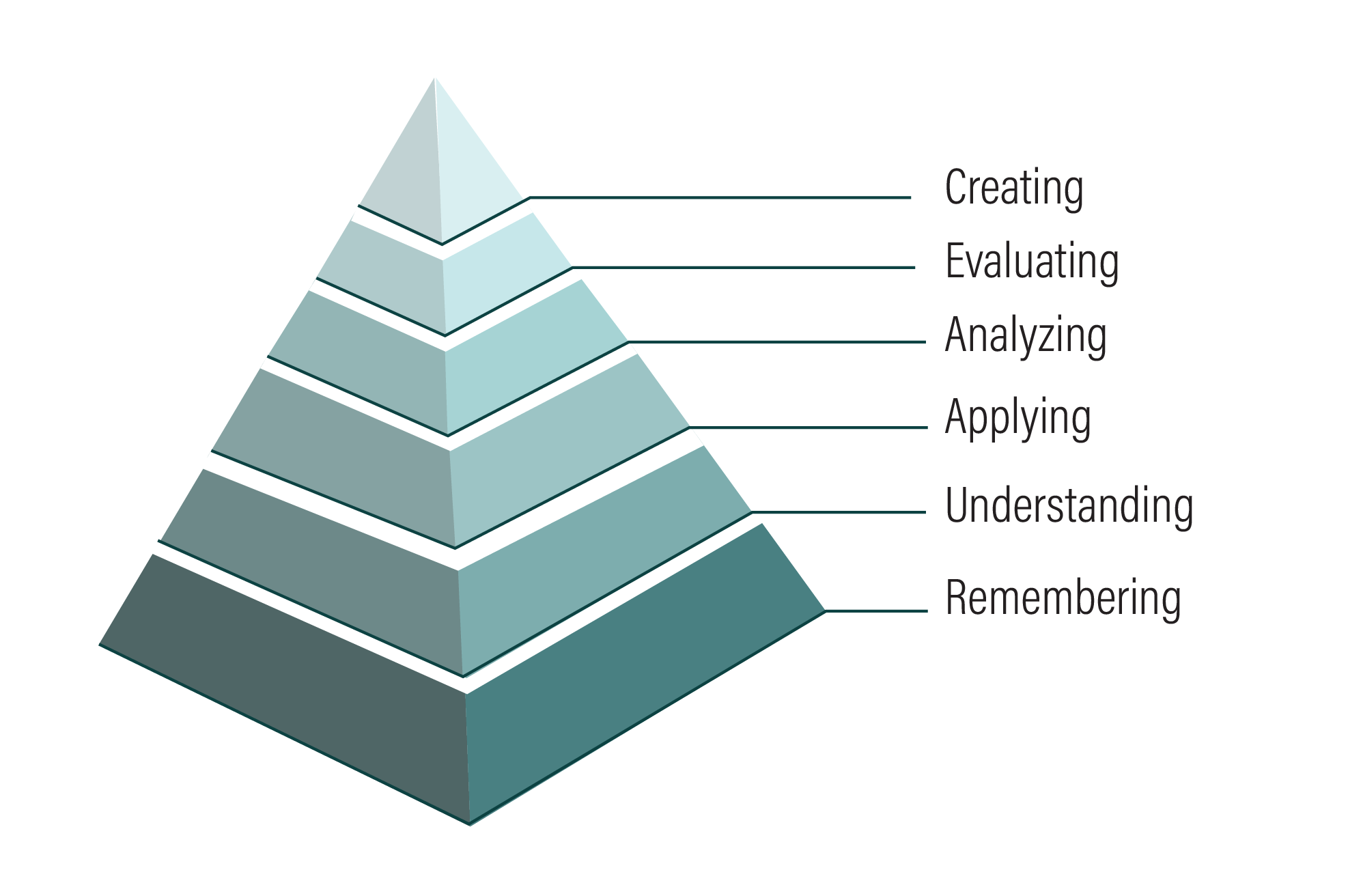 Overview
Overview
Bloom’s Taxonomy is a hierarchical framework created to promote higher forms of thinking in education. Bloom’s Taxonomy is widely used by educators to design curricula that promote higher-order thinking and to create assessments that measure various levels of cognitive ability. The framework is used in education to categorize cognitive skills, guiding the development of learning objectives, assessments, and activities. It encourages a progression from simple recall to complex, creative thinking.
Bloom’s Taxonomy was created in 1956 by educational psychologist Dr. Benjamin Bloom and revised in 2001 by Anderson and Kathwohl.
| Bloom’s Taxonomy
(Bloom, 1956) |
Bloom’s Taxonomy (Revised)
(Anderson & Kathwohl, 2001) |
| Evaluation | Create |
| Synthesis | Evaluate |
| Analysis | Analyze |
| Application | Apply |
| Comprehension | Understand |
| Knowledge | Remember |
The taxonomy divides cognitive processes into six levels, arranged from lower to higher order thinking skills:
- Remembering – recalling facts and basic concepts.
- Understanding – explaining ideas or concepts.
- Applying – using information in new situations.
- Analyzing – breaking down information into components and understanding relationships.
- Evaluating – making judgments or forming opinions based on criteria.
- Creating – generating new ideas, products, or ways of viewing things.
In Practice
How Can Bloom’s Taxonomy Help Me?
Bloom’s Taxonomy can help a faculty member by providing a structured framework to design more effective and balanced learning experiences. It guides instructors to set clear learning objectives at various cognitive levels, ensuring students deepen their understanding and develop critical thinking skills.
As a task progresses up the levels of Bloom’s it becomes more complex. For example, “analyzing” or “evaluating” concepts, processes, procedures, and principles, rather than just “remembering” facts.
Here’s an example of a learning activity or objective for each level of Bloom’s Taxonomy in a higher education course, such as a course on environmental science:
- Remembering:
Recall the key components of the carbon cycle.
Example: List the main processes involved in the carbon cycle.
- Understanding:
Explain how the greenhouse effect contributes to global warming.
Example: Summarize the role of greenhouse gases in maintaining Earth’s temperature.
- Applying:
Use data to calculate the carbon footprint of a household.
Example: Given local emissions data, estimate the annual carbon emissions for a typical family.
- Analyzing:
Compare the effectiveness of different renewable energy sources.
Example: Analyze the advantages and disadvantages of solar versus wind energy in specific climates.
- Evaluating:
Judge the sustainability of a proposed environmental policy.
Example: Critically evaluate the potential impacts and feasibility of implementing a carbon tax in a developing country.
- Creating:
Design a community-based project to reduce local air pollution.
Example: Develop a comprehensive action plan that includes strategies, stakeholders, and measurable goals.
Resources
Bloom’s Taxonomy Verb Chart | TIPS
Using Bloom’s Taxonomy to Write Effective Learning Objectives
Bloom’s Taxonomy Teaching Resources | Teach Starter
Resources For Teaching With Bloom’s Taxonomy
References
Anderson, L. W., & Krathwohl, D. R. (2001). A taxonomy for learning, teaching, and assessing: A revision of Bloom’s taxonomy of educational objectives: complete edition. Addison Wesley Longman, Inc..
Chandio, M. T., Pandhiani, S. M., & Iqbal, R. (2016). Bloom’s Taxonomy: Improving Assessment and Teaching-Learning Process. Journal of education and educational development, 3(2), 203-221.
Forehand, M. (2010). Bloom’s taxonomy. Emerging perspectives on learning, teaching, and technology, 41(4), 47-56.
Iowa State University. (n.d.). Revised Bloom’s Handout.pdf. Powered by Box.
Krathwohl, D. R. (2002). A revision of Bloom’s taxonomy: An overview. Theory into practice, 41(4), 212-218.
Lau, K. H., Lam, T. K., Kam, B. H., Nkhoma, M., & Richardson, J. (2018). Benchmarking higher education programs through alignment analysis based on the revised Bloom’s taxonomy. Benchmarking: An International Journal, 25(8), 2828-2849.
Nkhoma, M. Z., Lam, T. K., Sriratanaviriyakul, N., Richardson, J., Kam, B., & Lau, K. H. (2017). Unpacking the revised Bloom’s taxonomy: developing case-based learning activities. Education+ Training, 59(3), 250-264.
Noble, T. (2004). Integrating the revised Bloom’s taxonomy with multiple intelligences: A planning tool for curriculum differentiation. Teachers college record, 106(1), 193-211.
Ramalingam, M., Kasilingam, G., & Chinnavan, E. (2014). Assessment of learning domains to improve student’s learning in higher education. Journal of Young Pharmacists, 6(1), 27.
The Gold Scales. (n.d.). The taxonomy of learning and Benjamin Bloom. Oaks.
Author: Jennifer Parker, Ed.D.
Last Reviewed/Updated: July 2025
 Overview
Overview